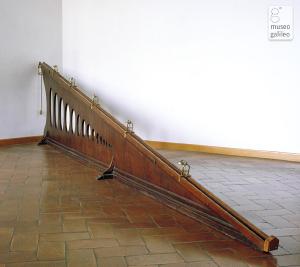Blog
Wonder Falls
12 November 2014
There’s a new video from Human Universe where Brian Cox shows how, in a vacuum, a bowling ball and feathers fall at the same rate. The idea that all objects fall at the same rate regardless of their mass is often attributed to Galileo. It’s commonly said that Galileo proved this fact to be true by dropping masses off the leaning tower of Pisa. But in fact it’s quite likely that Galileo never performed the experiment. Given the experimental apparatus at the time, it’s unlikely that such an experiment would be conclusive anyway. So why was Galileo convinced that objects fall at the same rate?
Galileo wasn’t the first to propose the idea, now known as the equivalence principle. Nearly a century before the publication of Galileo’s Two New Sciences, historian Benedetto Varchi writes of the idea in opposition to Aristotle’s claim that heavier bodies fall faster. A few years before Galileo’s claim, Simon Stevin performs an experiment with two lead balls, and from the sounds of their impacts concludes that they fell at the same rate. The reason we attribute the idea to Galileo is not because he was the first to claim it, but rather that he clearly outlined why it should be true.
 Museo Galileo
Museo GalileoGalileo studied gravity by experimenting with inclined planes. He rolled balls down an inclined plane such that the ball would strike a bell at specific intervals. From this he showed that the distance a ball rolled with each unit of time followed a pattern of odd numbers. In one moment it would roll one unit of distance. In the next moment 3 units, then 5, 7 and so on. The unit of distance increased with successively higher inclines, but the pattern was always the same. In this way Galileo demonstrated that objects fell down an incline at a constant rate.
Galileo also demonstrated the property of inertia. Aristotle claimed that objects fell to Earth because of their natural motion toward the Earth. A heavier object has a stronger natural motion, therefore should fall faster. But Galileo showed that rolling objects did not naturally move toward the Earth. If two inclined planes are placed against each other, a ball can roll down one then up the other one until it almost reaches its starting height. With a longer and shallower inclined plane, the ball still reaches about the same final height. In principle, if the second inclined plane were made flat, the ball would roll forever. From this Galileo argued that objects had a property of inertia, which meant that objects would continue to move unless something stopped it.
 Gary Garber
Gary GarberIt is from the property of inertia that Galileo argued for the equivalence principle. To prove Aristotle wrong, he used a simple thought experiment. Suppose that heavier objects did, in fact, fall faster than lighter ones. If that were true, then if we dropped a small lead ball and a large lead ball from a tall tower, the large ball would strike the ground first. But suppose we then connected the two balls and dropped them alongside another large lead ball. According to Aristotle, the connected lead balls are heavier than the single large ball, so they should strike the ground first. But according to Aristotle, the connected lead balls should fall more slowly because the lighter ball is trying to fall less quickly. From this contradiction Galileo concluded that all masses must fall at the same rate. Gravity must change the inertia of all masses equally.
Galileo was able to get the correct answer, and he did it by wondering about how things fall.